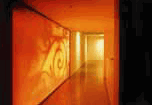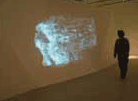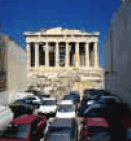



















MEDITERRANEANS Exhibition at MACRO at Mattatoio - Rome
From 4th of June till 19th of September 2004
With "MEDITERRANEANS" Museum of Contemporary Art of Rome - MACRO initiated a huge exhibitive project that involved ten curators and about forty-five artists on the theme of Mediterranean, or more precisely, on how from the present standing-point might be observed and re-defined this incredibly complex area that in the last years has been stage of profound transformations on political, economical, social and of course, cultural level.
What occurred from the very beginning to the team of the curators involved - Zdenka Badivinec (Slovenia), Ami Barak (France), Dobrila Denegri (Serbia/Montenegro), Katerina Gregos (Grece), Mai Abu El Dahab (Egypt), Vasif Kortun (Turkey), Gianfranco Maraniello (Italy), David G. Torres (Spain), Sarit Shapira (Israel) and Jalal Tuffic (Lebanon) - was that the Mediterranean needs to be considered as a sum of a number of sub-units which challenge or contest a-priori unifying ideas. Since ever this region has been a cross-road and point of encounter, a place where three continents (Europe, Africa and Asia) as well as three religions (Christianity, Islam and Judaism) meet, a spot where different ethnicities exist and different languages are spoken. It seemed difficult therefore, to regard the Mediterranean as a coherent whole without taking account of the fractures which divide it, and the tensions which are tearing it apart: Palestine Israel, the western Balkans, Lebanon, Cyprus, Greece Turkey, Algeria; incidents with their roots in other, more distant conflicts. Therefore seemed essential to orientate the discourse towards the questions that are extremely urgent today, and which asks how contemporary art reflects on the possibilities of establishing a dialogue between peoples and cultures in the broader context of economic globalisation, enlargement of the European Union, the permanent presence on its soil of communities of immigrant origin, and the questions about identity which these changes are throwing up on both shores of the Mediterranean.
Therefore this exhibition, realised in the huge new spaces of the MACRO al Mattatoio, appears like a multi-directional insight to different realities that compose this unsettled "Mediterranean" puzzle. It appears also an attempt to trace "trans-Mediterranean" features also through the principle of choice that guided each curator; so in fact, the tendency was to mix and go above strict regional and geographical borders, and invite artists coming from other areas as well. For instance, the selection of Vasif Kortun comprehended besides Turkish artists, also Croat Slaven Tolj, Egyptian Wael Schawky or Palestinian Khalil Rabbah, Katerina Gregos invited Yana Bartana from Israel, or Israeli curator Sarit Shapira two artists coming from Palestine: Raida Saideh (Umm el-Fahem) and Sharif Waked (Nazareth). Many artists themselves moved out from their countries of origin in the last years, so we could find Anri Sala (Albania), Mircea Cantor (Romania) or Melik Ohanian (Armenian by origin) and Adel Abdessemed (Algerian) in the selection of the curator for France Ami Barak, a Russian, based in Slovenia Vadim Fischin for the Balkans, or Iranian raised in Rome living in USA, Avish Khebrehzadeh for Italy. This denotes that moving and migrating has been ever present in the basin, and is even more now when processes of globalisation is bringing fundamental changes on both it's shores. Hence seemed crucial to focus on the phenomena of hybrid and multiple identities, and to try to underline and represent actual itineraries of transformation from past, historical paradigms to present ones.
Therefore we might observe the processes of "constructing-democracies" as well as those of change of the urban landscape of the capital of Albania, for instance, through the film "Dammi colori" by Anri Sala or "Changing Landscape" by Mircea Cantor, and similar reflections on the passage from past to present in the video by Egyptian Hassan Khan, in the photos of Greeks Panos Kokkinias and digitally manipulated prints by Dimitris Tsoublekas or Egyptian Iman Issa, as well as in the work about Beirut by Walid Raad. The process of passage from one place to the other, of moving as a real and mental dimension, is a theme of the works by Spanish Marti Anson and Greek DeAnna Maganias, as well as of the works by multidisciplinary and eclectic artist from Turkey Huseyin Chalayan who focused on the theme of emigration and resettlement. Same topic explored also Andreja Kuluncic from more socio-political aspects, radically denouncing difficult status of the foreign immigrants in Europe. The drama of the war which shakes many of Mediterranean areas and the consciousness of the fragility of the human existence is depicted through the works by Israeli artists Gill Shani who realised space installation with a great number of drawings as well as video installation by Amit Goren or photos by Croatian artist Slaven Tolj. With his huge installation dedicated to the "Museum of Palestine" also Khalil Rabbah was indicating a need to reflect upon the processes of destruction and maintenance of the memory and recollection. In between the concern about recent past and necessity to turn towards the future was the interactive computer projection by Victoria Vesna (originally from Serbia and Montenegro, living in US) entitled "Balkan Ghosts". This work would capture the images of the viewers and elaborate them in the real time fragmentising the human shapes and merging them with text that narrates about the tragic destiny of Balkanise populations, almost as turning the spectators to the "Balkan ghosts". After important exhibitions about Balkans that has been realised in Graz, Vienna and Kassel that summed up the last ten years of war, dissolution and identity crisis, appeared necessary to try to indicate new directions in which younger generations of artists are moving. These directions hypothesizes more constructive approaches, creations of new utopias within contemporary hi-tech world, as we can observe in the works by Slovenian duo Son:Da, Tobias Putrih, Vadim Fischin or Croatian Tomo Savic-Gecan.
These are therefore some of the examples of how this exhibition about multiplicity of "MEDITERRANEANS" attempted to create a fragmentary and panoramic view on the region that currently has been going through the shifts and displacement of established frameworks and reference points as a result of the mixing of peoples and ideas, and flows of goods and services, which led us to conclude that it is not always entirely possible to identify what has remained unchanged in the different "civilisations" where these transformations have taken place. This exhibition tried to focus on some particular issues in order to offer more general view. Leopold Sedar Senghor encapsulated this when he said that by living the particular to the full we reach the dawn of the universal. A common civilisation naturally looks to the universal, and hence equality, while dialogue thrives on diversity, and hence a taste for difference.
Dobrila Denegri
|
|
 |
|
|
||||||||||||||||||
 |
 |
 |
|
||||||||||||||||||
|
|
|
||||||||||||||||||||
 |
 |
|
 |
|
|
||||||||||||||||
|
|
|
|
|||||||||||||||||||
 |
|
 |
|
|
|||||||||||||||||
 |
 |
|
 |
|
 |
|
|
|
|||||||||||||
|
|
|
||||||||||||||||||||
| |
|
||||||||||||||||||||
 |
|
||||||||||||||||||||
 |
|
||||||||||||||||||||
 |
|
||||||||||||||||||||
|
|
|
||||||||||||||||||||
|
|
|
||||||||||||||||||||
|
|
 |
|
|
||||||||||||||||||
|
|
 |
|
|
||||||||||||||||||
 |
|
||||||||||||||||||||
 |
|
||||||||||||||||||||
|
|
|
|
|
|
|
|
|
|
|
|
|
|
|
|
|
|
|
|
|
|
|